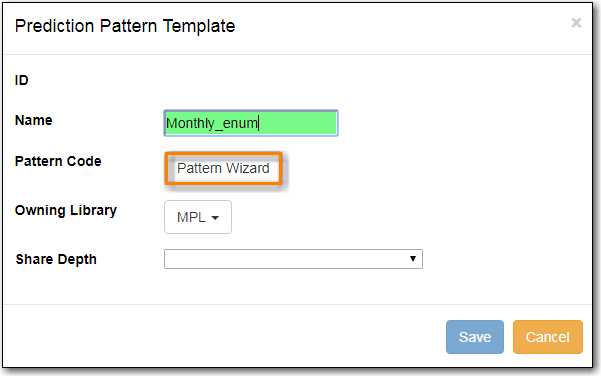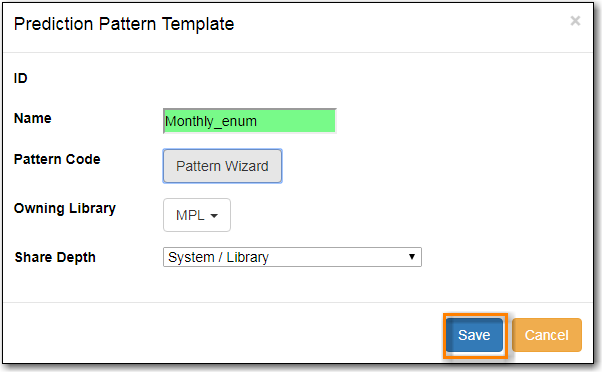Click Administration → Serials Administration → Prediction Pattern Templates.

Click New Record.

- Enter a Name.
Click Pattern Wizard. The wizard has five tabs that will step you through creating a prediction pattern for your publication.

- See the section called “Pattern Wizard” for detailed instructions.
- Choose the Owning Library.
- Choose the Share Depth.
Click Save.

Enumeration Labels
Select the radio button adjacent to Use enumerations.
- The enumerations conform to $a-$h of the 853,854 and 855 MARC tags.
- If the publication only uses dates, select the radio button adjacent to Use Calendar Dates Only and click Next in the upper right-hand corner. Skip to next step.
Enter the first level of enumeration in the field labeled Level 1 → Click Add Level.
- A common first level enumeration is volume, or "v.".
Enter the second level of enumeration in the field labeled Level 2.
- A common second level enumeration is number, or "no.".
Select if the second level of enumeration is a set Number, Varies, or is Undetermined.
Number - Enter the number of bibliographic units per next higher level (e.g. 12 no. per v.).
- This conforms to $u in the 853, 854, and 855 MARC tags.
Select the radio button for the enumeration scheme: Restarts at unit completion or Increments continuously.
- This conforms to $v in the 853, 854, and 855 MARC tags.
- Check the box adjacent to Add alternative enumeration if the publication uses an alternative enumeration.
Check the box adjacent to First level enumeration changes during subscription year to configure calendar changes if needed.
- A common calendar change is for the first level of enumeration to increment every January.
- Select when the Change occurs from the drop down menu: Start of the month, Specific date, or Start of season.
- Select the specific point in time at which the first level of enumeration should change.
- Click Next

Chronology display
- Check the box adjacent to Use Chronology Captions?
- Choose a chronological unit for the first level.
Do not check Display level descriptor?.
- If checked the term for the unit selected, such as "Year" and "Month" will display next to the chronology caption in the catalog.
To add additional levels of chronology for display, click Add level.
- Each level that you add must be a smaller chronological unit than the previous level (e.g. Level 1 = Year, Level 2 = Month).
- Check the box adjacent to Use Alternative Chronology Captions? If the publication uses alternative chronology.
- Click Next

MFHD Indicators
Choose a Compression Display Option
- Compressibility and expandability correspond to the first indicator in the 853 tag.
- Sitka recommends Can compress or expand
Choose a Caption Evaluation
- Caption Evaluation corresponds to the second indicator in the 853 tag.
- Sitka recommends Captions verified; all levels present
- Click Next

Frequency and Regularity
Click the radio button for Pre-selected and choose the frequency from the drop down menu.
- Alternatively- Use number of issues per year and enter the total number of issues in the field.
If the publication has combined, skipped, or special issues, that should be accounted for in the publication pattern, check the box adjacent to Use specific regularity information?.
- From the first drop down menu, select the appropriate publication information: Combined, Omitted, or Published issues.
- From the subsequent drop down menus, select the appropriate frequency and issue information.
- Add additional regularity rows as needed.
For a Combined issue, enter the relevant combined issue code.
- E.g., for a monthly combined issue, enter 02/03 to specify that February and March are combined.
Click Next

Review
Review the Pattern Summary
Click the blue arrows to see the Raw Pattern Code

- Click Save
- Click Administration → Serials Administration → Prediction Pattern Templates.
- Click the check box beside the template you want to edit.
Click Actions → Choose Edit Record.

Note
Prediction Patterns can be edited after creation as long as all predicted issues have the status of "Expected". Once an issue is moved into a different status, the Prediction Pattern cannot be changed.
- Click Administration → Serials Administration → Prediction Pattern Templates.
- Click the check box beside the template you want to delete.
Click Actions → Choose Delete Selected.

Note
Prediction Pattern Templates that are being used by subscriptions cannot be deleted.
